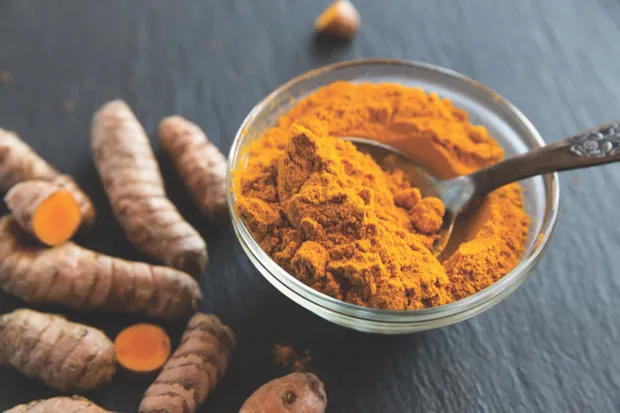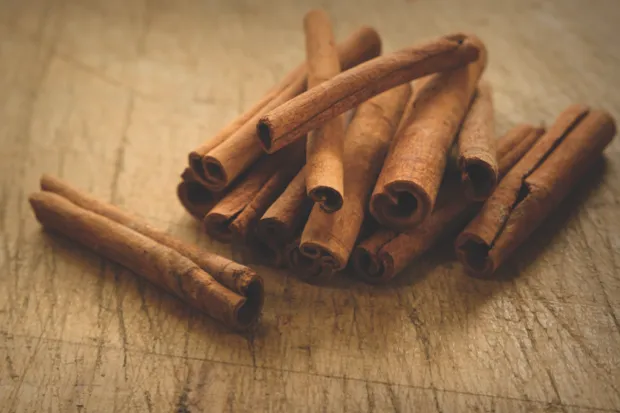We Brits love a good curry, and despite the obvious hits to your wallet and, aherm, constitution, ordering a delicious takeaway every once in a while could have some unexpected benefits. We look at how the turmeric in your tikka could help boost your memory, the chillies in your vindaloo could help with pain relief, and how saffron can spice up your sex life.
Saffron

Good for:
- Mild depression
- Delaying cognitive decline
- Sexual function
Perhaps best known as the world’s most expensive spice, saffron has an alluring yellow colour and a subtly floral, slightly bitter taste. The golden strands are the dried stigmata (part of the female reproductive system) of Crocus sativus flowers. With a health-boosting reputation to match its price tag, saffron is packed full of antioxidants and many studies point to its cancer-fighting properties. It’s also said to be good for the brain.
Some human studies suggest that taking 30mg per day may help to ease mild depression; others show that a daily dose may improve cognitive function in the early stages of Alzheimer’s disease. And that’s before we get to saffron’s famed aphrodisiac qualities, illustrated by an Iranian study showing that a month’s saffron treatment gave a boost to sexual function in women who had been treated for depression.
A month’s saffron treatment gave a boost to sexual function in women who had been treated for depression
The spice contains hundreds of compounds, but its main biological components are safranal, crocin and picrocrocin, which deliver its aroma, colour and bitter taste. Of these, crocin and a related chemical called crocetin are largely responsible for its superpowers. Crocin has been shown to protect brain cells and act as an antidepressant, and also has a record of inhibiting tumour growth for a range of cancers in rodents, including breast and prostate.
At United Arab Emirates University, Dr Amr Amin’s team claims to have developed a method for treating cancerous liver cells using magnetite (iron) particles coated with crocin. “Our group provided evidence that saffron exerts a significant chemopreventative effect against both liver and colorectal cancer through different molecular mechanisms,” he says. Meanwhile, scientists at the University of Kansas suggest that crocetin can inhibit pancreatic cancer cells, both in a petri dish and in mice. The team recently made crocetinic acid, which appears to have even more potent cancer-fighting abilities.
Try it!
Studies recommend a daily dose of 30mg. Enthusiasts often opt for a simple tea, which can be repeatedly topped up with hot water until the threads have released all of their goodness.
Turmeric

Good for:
- Arthritis
- Memory complaints
- Inflammation
This earthy, golden spice comes from the root of a plant in the ginger family and is the main ingredient in curry powder. Turmeric has been used for medicinal purposes for nearly 4,000 years and is billed as being able to cure a dazzling array of ailments, from arthritis to erectile dysfunction, largely thanks to its main ingredient, curcumin.
But most clinical trials featuring humans have not shown clear benefits from consuming turmeric. Curcumin is difficult to study because it is not terribly stable and does not dissolve easily in water, which means it cannot be used by the body. In fact, research suggests that most curcumin is likely to travel straight through the digestive system, without being absorbed. Pharmaceutical researchers often refer to curcumin as a ‘false lead’ because it looks amazing on paper but is ineffective in reality.
The key lies in adapting the structure of curcumin, or attaching it to a chemical transporter. In 2011, stroke researchers at the Cedars-Sinai Medical Center, US, found that an adapted curcumin structure was able to repair stroke damage in rabbits. At the University of Illinois, a team of researchers have found a way to smuggle curcumin to targets in the body using platinum-based compounds. The result is a complex that appears to be effective at treating various cancers, including melanoma and breast cancer.
Similarly, in lab tests at the University of Florida, scientists have attached curcumin to nanoparticles to destroy cells from neuroblastoma, a cancer that is most commonly diagnosed in children. The research suggests that the nanoparticles kill the cancer cells, although more study is needed to discover if the treatment would work in humans.
There is also evidence that curcumin can help with memory problems. A team at the University of California, Los Angeles, selected a widely available curcumin supplement called theracurmin for their study on 40 adults with mild memory complaints. Participants took a placebo or 90 milligrams of theracurmin twice daily for 18 months. The supplement gave the participants a significant memory boost, while PET scans showed lower levels of protein plaques in their brain.
“We think that the anti-inflammatory effects of curcumin may be protecting the brain,” explains lead researcher Dr Gary Small. “We are currently in the planning stage for our next study, which will attempt to replicate these findings and determine if curcumin’s mood-elevating effects contribute to the cognitive benefits.”
Try it!
You probably need to consume at least one teaspoon per day. Try a turmeric shot, made palatable by adding fruit juice or coconut water, or even adding it to your latte. Or you could opt for a turmeric extract or supplement.
Cinnamon

Good for:
- Flatulence
- Memory and learning
- Fat loss
This aromatic tree bark is used in a dazzling array of sweet and savoury dishes. It tastes great and has long been used in traditional medicine, particularly for treating flatulence and digestive imbalance.
Research suggests that a common form of cinnamon, called cassia, may lower blood glucose levels in people with type 2 diabetes. Although the results have yet to be confirmed, a small study at Raabe College of Pharmacy at Ohio Northern University recently showed than the cassia species of cinnamon is more effective at lowering blood glucose levels than diet alone. Amy Stockert and her team suggest that chemicals in cinnamon may bind to an enzyme in the insulin-signalling pathway.
Cinnamon’s appealing aroma and flavour come mainly from a chemical called cinnamaldehyde, which has antibacterial and anti-fungal properties. Some research suggests that the substance may help to protect against obesity, though perhaps not when consumed in cinnamon pastries. At the University of Michigan, research in humans suggests that cinnamaldehyde may act directly on fat cells, inducing them to start burning energy. The chemical increased expression of several genes and enzymes that enhance lipid metabolism.
Research suggests that cinnamaldehyde may act directly on fat cells, inducing them to start burning energy
There is also evidence that cinnamon may have brain boosting properties. A study at Rush University Medical Center in Chicago, US, found that cinnamon appeared to help mice to learn, if their ability to navigate a complex maze is anything to go by. The cinnamon increased levels of a protein involved in memory and learning called CREB. The researchers point out that the body metabolises cinnamon to form sodium benzoate, commonly used as a chemical treatment for brain injuries. But think twice before you ingest vast quantities of cinnamon: it can contain high concentrations of a substance called coumarin, which can cause liver damage.
Try it!
Cassia cinnamon is moderately toxic to the liver and kidneys, so you’d be better advised to opt for Ceylon cinnamon. Add it to your favourite curries and dessert dishes.
Chillies

Good for:
- Pain relief
- High blood pressure
- Maintaining a healthy weight
Chilli peppers originated in Mexico over 6,000 years ago but spread around the globe after Columbus got his hands on them. They get their spicy heat from capsaicin and a group of related chemicals called capsaicinoids. Extracted capsaicin is odourless and colourless, but its fiery punch is fierce: it’s the main active ingredient in pepper spray. But it’s also used as a pain reliever in many topical ointments, nasal sprays and dermal patches, and capsaicin creams have been proven to be effective for treating osteoarthritis pain.
Capsaicin depletes levels of the neuropeptide Substance P, which plays a key role in transmitting pain signals to the brain, as well as activating inflammatory chemicals in joints. In 2015, a team from the Chinese Academy of Medical Sciences tracked the health of nearly half a million people over several years. Those who ate chilli-rich food once or twice a week had a lower mortality rate than those who abstained, and daily chilli consumers had an even better chance of survival. It’s not known quite why this is the case, but further analysis of data from the China Health and Nutrition survey suggests that higher consumption of chillies is also linked to lower levels of obesity. Meanwhile, a recent Australian study suggests that chilli-eaters are less likely to have high blood pressure. Capsaicin relaxes blood vessels by increasing production of nitric oxide, which protects against inflammation.
Then there’s the potential to fight cancer. Recent evidence suggests capsaicin may help to prevent certain cancers forming and to stop tumours growing. For example, capsaicin is thought to be able to kill prostate cancer cells. Indian researchers carrying out lab tests found that the compound binds to a cell’s surface, causing membranes to rupture. There are also suggestions that chilli may help to prevent cancers from metastasising. But clinical development of capsaicin as an anti-cancer drug is limited due to side effects such as a burning sensation, stomach cramps and nausea. US scientists have got around this by making slightly different, more potent versions of capsaicin that retain the biological activity but not the heat.
Even in terms of basic nutrition, chillies have high levels of vitamins A and C. All the more reason to eat lots of curries! If you’re not a big chilli fan, bear in mind that the pain you feel when capsaicinoids bind to heat-receptor proteins in the mouth will fade the more regularly you eat it, as those receptors become desensitised, so you’ll soon be able to handle hotter and hotter varieties.
Try it!
Some fanatics suggest adding chilli to all main meals – and why not? If you have a sensitive stomach, dried chillies may be gentler. If you’re not a heat freak, go for green chillies, which tend to be cooler but still deliver a powerful punch of the all-important capsaicin.
Ginger

Good for:
- Nausea
- Type 2 diabetes
- Arthritis
This instantly recognisable gnarly root comes from the same botanical family as turmeric and has been used as far back as the 4th Century BC for stomach ache, nausea and diarrhoea. Legend has it that the Ancient Greeks used it to combat nausea after the excesses of an orgy.
Ginger is generally soothing and satisfying. Its power to cure nausea means it is regularly prescribed to pregnant women without fear of side effects. Meanwhile, it’s also reputed to be able to help fight cancer, though most tests so far have been carried out on isolated cells rather than in animals. Perhaps less important but more reassuring is the little-known fact that ginger promotes sweating – it is a so-called ‘diaphoretic’ – so it makes us feel warm, especially when we’re feeling under the weather.
Ginger’s ability to relieve nausea, arthritis and pain are generally attributed to aptly named chemicals called gingerols. A couple of these, 6-gingerol and 10-gingerol, are currently being investigated to prevent and treat cancer. It can lower blood glucose levels, and recent animal studies have homed in on 6-gingerol to help protect against type 2 diabetes.
One study on mice with the disease, for instance, showed that 6-gingerol increased insulin levels. Japanese tests on rats suggest that the chemical has anti-diabetic potential through a range of different mechanisms. They found that it can affect genes related to glucose metabolism and suggest that it could be used to treat as well as prevent type 2 diabetes. Combining 6-gingerol with a bitter chemical called quercetin, found in red onion and kale but also available as a supplement, significantly boosts the anti-diabetic effects, scientists from Nanchang in China have found.
And that’s not all. Heating ginger causes substances called shogaols to form, giving the dried spice its characteristic pungent taste and aroma. The most common is 6-shogaol, which is currently causing much excitement in research circles, with studies suggesting that it can protect the brain and possibly help to fight cancer. For example, a 2015 laboratory study in India revealed that 6-shogaol may be better than conventional chemotherapy. Other studies suggest that 6-shogaol may help to fight gastric, colon, and colorectal cancer.
Try it!
Ginger can be used fresh or dried and powdered, and studies suggest that as little as 2g of ginger per day may be enough to lower blood sugar. Ginger biscuit, anyone?
- This is an extract from issue 327 ofBBC Focusmagazine -subscribehere
Follow Science Focus onTwitter,Facebook, Instagramand Flipboard